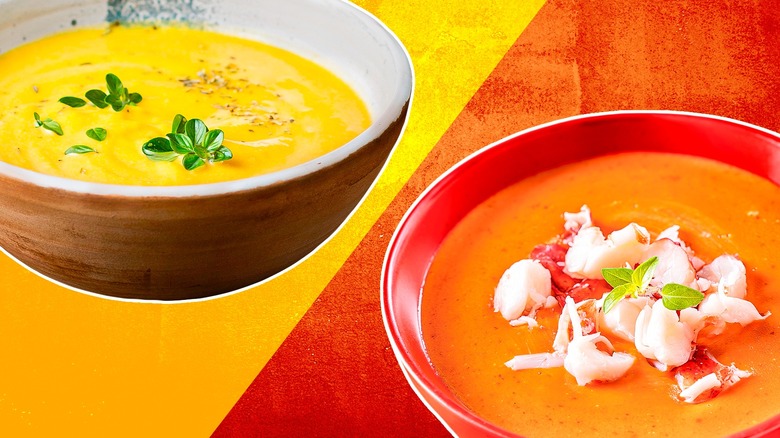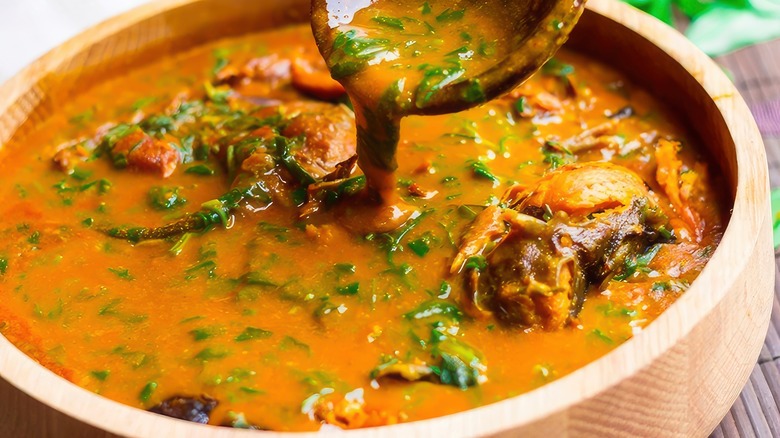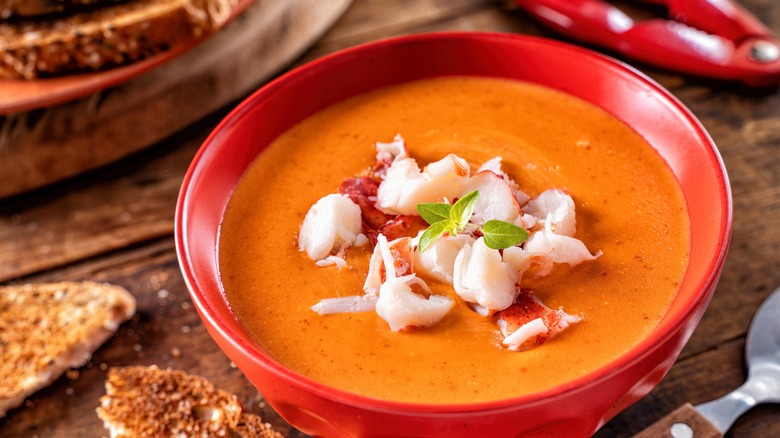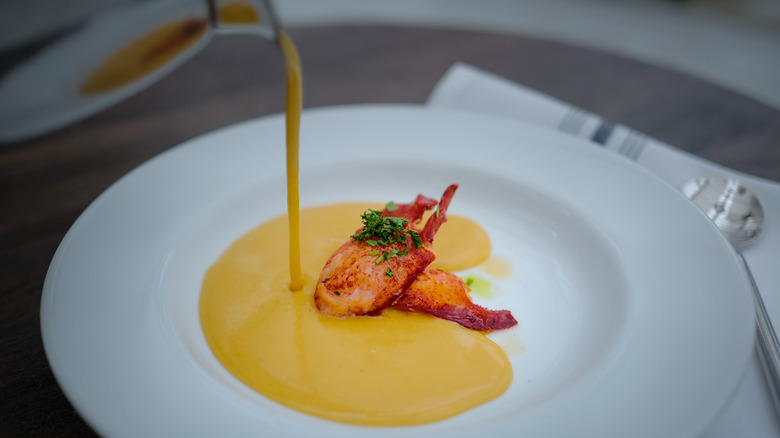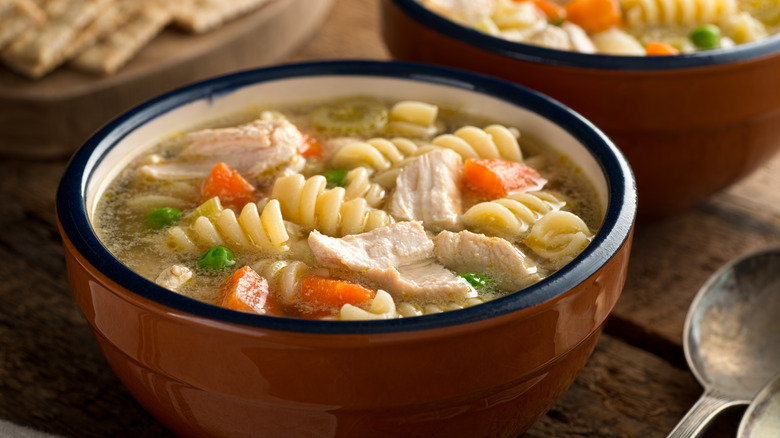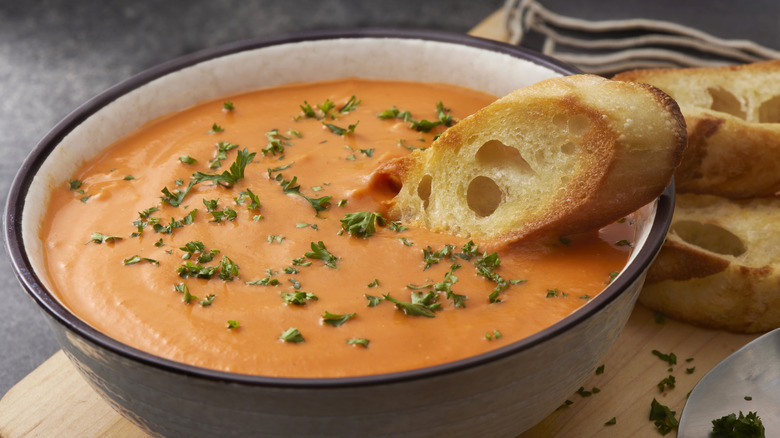The Main Differences Between Soup And Bisque
When it comes to the culinary world, few dishes offer the comfort and satisfaction of a bowl of soup. These warming dishes have graced our tables for centuries, providing sustenance and heat during cold days. However, not all soups are created equal.
Soup and bisque, both beloved culinary creations, share a common foundation in their liquid nature but stand apart in their essence and preparation. While bisque is technically a soup, it stands apart in the culinary world as its own special type of dish. Generally, soup, the versatile comfort food found in kitchens across the globe, is a flavorful liquid simmered to perfection with a myriad of ingredients. On the other hand, bisque, hailing from the refined realms of French cuisine, is a seafood lover's dream, taking a more specialized path of preparation, that usually starts with a stock of crustacean shells and ends in a silky smooth creamy concoction.
In essence, while both soup and bisque share the comforting effect of a warm, liquid embrace, bisque takes the concept to a higher level, weaving an intricate tapestry of flavors and textures that make it a true indulgence.
If you've ever wondered what separates a soup from a bisque, now is the time to delve into the key differences between the two. From their origins to the bases, textures, and flavors of soups and bisques, you can appreciate each in its own unique way.
What is soup?
Soup, the culinary comfort that transcends borders and cultures, is a liquid masterpiece that captures the essence of nourishment in a single bowl. At its core, soup is a harmonious blend of flavors and textures, a symphony of ingredients simmered to perfection. It's a canvas upon which culinary creativity knows no bounds, with ingredients as diverse as the world's cultures.
Soup can be traced back to ancient times when our ancestors first began simmering ingredients in water to create simple broths. We're talking as long ago as 6000 B.C. from when a recipe exists for a meaty Sumerian broth. Over the centuries, soups evolved and diversified across cultures, with each region contributing its unique twist. Poor ancient Egyptians often ate barley broth, and it was the Chinese who came up with the art of simmering soup. Our word "soup" hails from the 17th-century French word "soupe," which means broth.
From hearty stews brimming with chunks of tender meat and vegetables to delicate consommés, soup embraces a seemingly endless spectrum of possibilities. It can be a soothing remedy for a chilly evening, a restorative dish, or a showcase of a chef's ingenuity. Its basic definition is a liquid food with a meat, fish, or vegetable stock base. But whether that's a steaming bowl of chicken noodle soup on a rainy day or a spicy bowl of ramen, crammed with ingredients, soup is the embodiment of a truly global comfort food.
What is bisque?
Bisque is a more refined creation that has its roots in 17th-century French cuisine. It evolved most significantly when it came over to America in the 1950s, becoming richer. The term bisque usually refers to a highly seasoned and creamy seafood soup made from shellfish, particularly lobster, crab, or shrimp. A bisque traditionally starts with boiling seafood shells for a luxury sweet stock. The meat from the crustaceans is often kept aside to add back into the soup at the end. The addition of aromatic ingredients like shallots, brandy, and a touch of tomato lends trademark depth and complexity to its flavor profile, which you don't usually find in other soups. This results in an exciting harmonious fusion of savory and slightly sweet notes. This refined dish is a staple at upscale dining establishments and a cherished indulgence for those seeking a taste of gourmet extravagance.
Today, while bisque is mostly associated with seafood, it can step outside of that realm, still retaining its creamy character. For example, think of a delicious bowl of tomato bisque served at your favorite bistro. Though this version strays from seafood, the technique and ingredients used to make the fruit-based bisque still qualify it as this specific type of soup. Whether enjoyed as an appetizer or a decadent main course, bisque is a testament to the art of transforming simple ingredients into an extraordinary dish.
Bisque is cream-based
One of the most significant differences between soup and bisque lies in their base. Soup, in its most fundamental form, relies on a liquid base, typically a clear or lightly flavored broth. This broth can be made from various sources, such as chicken, beef, vegetables, or seafood, and serves as the foundation for the soup's flavor profile. The ingredients in a soup can range from vegetables, legumes, and grains to meats and seafood. The magic of soup is often in the interplay of these ingredients, creating a harmonious, well-balanced broth that can be both comforting and nourishing.
Bisque, on the other hand, is characterized by its creamy and luxurious texture. While it will also incorporate a seafood broth or stock for depth of flavor, bisque is defined by the addition of heavy cream and, sometimes, a thickening agent, which imparts a rich, velvety consistency. Traditionally the thickener actually came from ground shells mixed with the cream, but is usually created today from a little cornstarch, or simply tomato paste and cream. However, it can also come from ground rice. This creamy base sets bisque apart, giving it a luscious mouthfeel that is unmistakable. Whether you're savoring a classic lobster bisque or a tomato bisque, that silky-smooth texture is a hallmark of this dish.
Soup can have a wide variety of textures
Soup often boasts a rustic and hearty texture but can be pureed too. The ingredients in a soup can vary in size, from chunky vegetables and meaty morsels to tender noodles or grains. This diversity in texture adds depth and complexity to the eating experience, providing a satisfying contrast between the soft and the firm. Whether you're enjoying a bowl of minestrone with chunks of fresh vegetables or a soulful chicken noodle soup with tender shreds of poultry, the texture of soup is often about embracing the diverse elements within. Even with pureed soups, a crouton or topping will be added for contrasting texture.
In stark contrast, bisque is all about silkiness. The creamy base and meticulous blending process ensure that every spoonful is velvety. Bisque offers a homogeneous, smooth consistency that glides over your palate. This silky texture contributes to the elegance and refinement that bisque is known for. While bisque might be topped with croutons, cheese, or bite-sized morsels of the seafood used to make it, the dish itself will be velvety-smooth.
Bisque is richer than soup
Soup is often celebrated for its deep and robust flavors. The broth, infused with the essence of its ingredients, becomes the heart and soul of the dish. Depending on the recipe, the best soups can be savory, spicy, sweet, or sour, but they are generally known for their hearty and comforting qualities. The complexity of flavors in a well-made soup is achieved through careful simmering, seasoning, and the interplay of diverse ingredients. In general, soup is thought of as an everyday dish, however, whereas bisque is more luxurious.
Bisque takes a more refined approach to flavor. While it can be rich and decadent, bisque tends to be focused on a few key elements. The primary flavor profile in a bisque often revolves around the main ingredient — be it lobster, crab, tomato, or another star ingredient. The creaminess of the base serves to complement and elevate this central flavor, allowing it to shine with finesse. This finesse of flavor is often enhanced by the use of alcohol when making the base, which could be white wine, sherry, brandy, or Pernod. Bisques are known for their delicate balance and the ability to showcase the essence of their primary ingredient without overpowering it. A spoonful of shrimp bisque, for instance, allows you to savor the delicate sweetness of the shrimp with a backdrop of subtle creaminess.
So, the next time you find yourself pondering whether to savor a comforting bowl of vegetable soup or indulge in a velvety lobster bisque, remember that the choice is not merely a matter of preference but an appreciation of the unique qualities of each dish.
